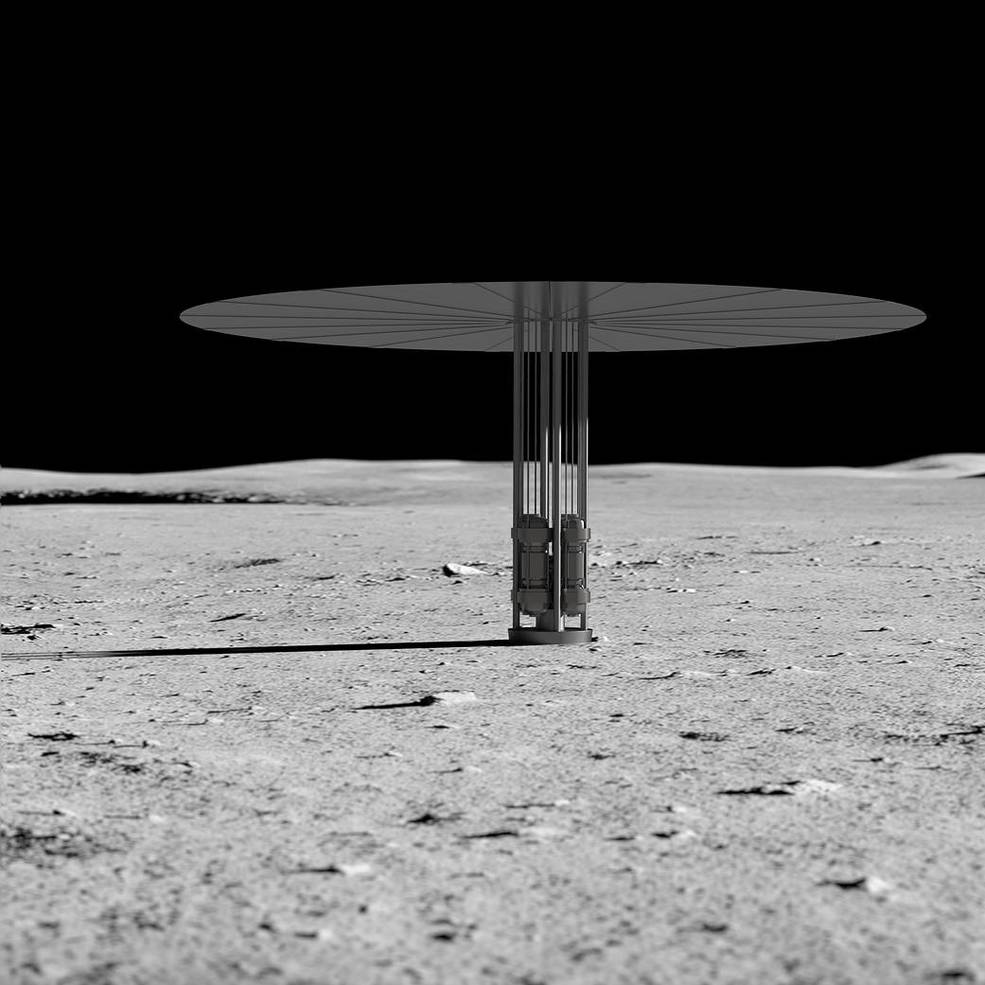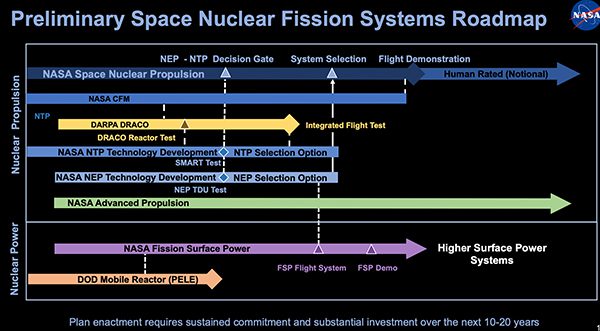NASA Picks Three Nuclear Power Concepts for Demonstration on the Moon

Three teams comprising some of the most prominent engineering and technology firms in the U.S. will provide initial designs for a fission surface power (FSP) system as part of a federal project to demonstrate a 40-kW nuclear reactor for power applications on the moon.
NASA and Battelle Energy Alliance-the contracted entity that manages and operates the Department of Energy's (DOE's) Idaho National Laboratory (INL)-on June 21 said they awarded contracts to three teams as part of a Phase 1 design effort for a lunar power FSP. Preliminary designs resulting from these selections will inform Phase 2, which would involve an industry solicitation for a final design of a flight-qualified" FSP. Phase 2 also involves the building, testing, and delivery of the FSP to the moon on a demonstration mission.
One team will be led by Lockheed Martin but also includes nuclear components and fuel provider BWXT Technologies, and engineering research firm Creare. Another team comprises nuclear technology giant Westinghouse and Aerojet Rocketdyne, a manufacturer of rocket, hypersonic, and electric propulsive systems. The third team will be led by IX, a joint venture between Intuitive Machines-a Houston-based firm that is completing its lunar program, which will provide lunar surface access, lunar orbit delivery, and communications at lunar distance-and nuclear technology company X-Energy. Space technology and intelligence company Maxar and aerospace firm Boeing are also part of the third team.
 Fission surface power systems-depicted in this conceptual illustration-could provide reliable power for human exploration of the Moon under Artemis. Source: NASA$5M Contracts for Each of the Three Design Concept Proposals
Fission surface power systems-depicted in this conceptual illustration-could provide reliable power for human exploration of the Moon under Artemis. Source: NASA$5M Contracts for Each of the Three Design Concept ProposalsDetails about the three selected design concept proposals have not yet been unveiled, though INL, which led the proposal evaluation, noted each of the three 12-month contracts is valued at about $5 million. The power system development is funded by NASA's Space Technology Mission Directorate's (STMD's) Technology Demonstration Missions program, which is located at Marshall Space Flight Center in Huntsville, Alabama. NASA's Glenn Research Center in Cleveland manages the fission surface power project.
The companies will target developing initial designs," said INL. This early design effort will provide key information to inform subsequent project activities." NASA in a statement, meanwhile, said the critical information it obtains from industry under the Phase 1 awards could lead to a joint development of a full flight-certified fission power system. Fission surface power technologies also will help NASA mature nuclear propulsion systems that rely on reactors to generate power. These systems could be used for deep space exploration missions," it said.
The contract awards respond to a request for proposals (RFP) Battelle and NASA issued in November 2021, asking American companies for FSP design concepts that could be ready to launch within a decade for a demonstration on the moon." NASA and Battelle, however, first unveiled their interest in private sector FSP designs in July 2020, driven partly by Trump administration-era initiatives.
NASA: Space Power Supports Space PresenceNASA in the RFI said that because space exploration is going further and spanning longer periods of time, the U.S. will need a lunar FSP system to provide reliable, durable, and resilient energy for an installation on the moon. NASA's STMD in that RFI eyed a launch readiness date no later than" Dec. 31, 2026.
But NASA has more recently acknowledged that the FSP project supports wider plans for a robust presence on the moon." NASA's newest initiative stems from the Artemis Plan, which seeks to collaborate with commercial and international partners and establish the first long-term presence on the Moon." Then, we will use what we learn on and around the Moon to take the next giant leap: sending the first astronauts to Mars," it says.
NASA says development of an FSP could be paired with solar cells, batteries, and fuel cells to provide power to operate rovers, conduct experiments, and use the moon's resources to produce water, propellant, and other supplies for life support." That's why the FSP must be able to sustain long-duration operations and establish an evolvable system.
Battelle has specified that FSP designs must have a capacity of at least 40 kWe, with technology that could be extended to higher power, and it must run continuously for at least 10 years. It must also be capable of being transported on a rover, and have the size and mass that would fit on a large lander.
A Roadmap That Takes Into Account Terrestrial Microreactor DevelopmentNASA's preliminary space nuclear fission systems roadmap, meanwhile, takes into account other federal development efforts, including the Department of Defense's (DOD's) Project Pele, a much-watched mobile microreactor prototype. DOD's Strategic Capabilities Office (SCO) recently issued a record of decision to demonstrate Project Pele at full operation for a minimum of three years at an INL site in Idaho Falls. The DOD on June 9 picked Lynchburg, Virginia-based BWXT Technologies to manufacture and deliver the prototype high-temperature gas-cooled (HTGR) mobile microreactor to INL for testing by 2024 under a $300 million contract.
 NASA's preliminary space nuclear fission systems roadmap envisions several milestones on the road to a demonstration of a fission surface power (FSP) on the moon. However, plan enactment will require sustained commitment and substantial investment over the next 10 to 20 years," NASA said. Source: NASA
NASA's preliminary space nuclear fission systems roadmap envisions several milestones on the road to a demonstration of a fission surface power (FSP) on the moon. However, plan enactment will require sustained commitment and substantial investment over the next 10 to 20 years," NASA said. Source: NASAFSP activities could also benefit from other federal terrestrial" development activities, including several megawatt-scale microreactors for off-grid power generation, high-assay low-enriched uranium (HALEU) development, and supercritical carbon dioxide Brayton systems for high-efficiency solar power applications, NASA says.
The Fission Surface Power project is a very achievable first step toward the U.S. establishing nuclear power on the moon, and I look forward to seeing what each of these teams will accomplish," said INL Director John Wagner. This project will also advance technologies that are directly relevant to nuclear electric propulsion systems for space applications."
NASA's roadmap, notably, envisions larger benefits from FSP development for its crewed nuclear electric propulsion (NEP) missions to Mars. NASA and the DOE are currently performing analyses and generating concepts for NEP missions under NASA's Mars Transportation Assessment Study (MTAS). FSP provides a more straightforward first step for space reactors before embarking on a high-power NEP system," NASA says.
The more-complex, high-power NEP reactor would benefit from the testing infrastructure and community-of-practice that would be established for FSP, providing a means for the developers to gain confidence on a relatively simple first system. Specific benefits would include ground testing facilities, modeling techniques, launch processing experience, and most importantly the means to exercise the new launch safety approval process with a much simpler first system," it added.
New technology drives our exploration of the Moon, Mars, and beyond," Jim Reuter, NASA STMD associate administrator, said on Tuesday. Developing these early designs will help us lay the groundwork for powering our long-term human presence on other worlds."
-Sonal Patelis a POWER senior associate editor (@sonalcpatel,@POWERmagazine).
The post NASA Picks Three Nuclear Power Concepts for Demonstration on the Moon appeared first on POWER Magazine.